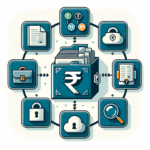Master Your Finances: Top Books and Resources for Learning Debt Management in India
The month-end notifications start pinging: the home loan EMI is due, the credit card bill from last month’s festive shopping has arrived, and the personal loan payment for the new home appliance is just around the corner. For a small business owner, it might be the reminder for the working capital loan payment that keeps you up at night. This cycle can feel relentless, making debt seem like an overwhelming burden that stifles financial growth and peace of mind. The first, most powerful step you can take towards breaking this cycle and achieving financial freedom is education. By understanding how debt works, you can make it work for you, not against you. This comprehensive guide will introduce you to the best debt management books and resources, curated specifically for the Indian context, to empower you on your journey to financial control. We will explore highly recommended books that build a strong foundation, valuable online resources for real-time learning, and actionable strategies for both salaried individuals and business owners in India.
Why Debt Management Education is a Non-Negotiable Skill in India
In today’s fast-paced economy, understanding debt is just as crucial as understanding investments. For many, financial literacy stops at earning and saving, but true financial well-being lies in mastering the entire spectrum of money management, including borrowing and repayment. A solid foundation in debt management education for beginners India is not just a good-to-have skill; it’s a non-negotiable requirement for building a secure future. It provides the knowledge to differentiate between strategic borrowing that builds assets and impulsive borrowing that drains wealth. This education is the firewall that protects your financial goals from being derailed by high-interest traps and poor borrowing decisions, enabling you to navigate India’s complex financial landscape with confidence and clarity.
For Salaried Professionals
For the salaried individual, the modern Indian marketplace presents a minefield of potential debt traps. Aggressive marketing for “buy now, pay later” schemes, instant personal loans for lifestyle upgrades, and the ubiquitous credit card can quickly lead to a spiral of high-cost EMIs. Effective debt management is your primary defense. By understanding the true cost of borrowing, you can avoid these pitfalls and make informed decisions. More importantly, managing your debts responsibly has a direct and significant impact on your CIBIL score. A high CIBIL score is your passport to financial opportunities, unlocking better interest rates and favourable terms for major life goals, such as securing a home loan, a car loan, or an education loan for your children, ultimately saving you lakhs of rupees over the long term. For instance, understanding tax benefits is also key, especially when considering Section 80E: Claiming Deductions on Education Loan Interest.
For Small Business Owners
For a small business owner, debt is a double-edged sword. Used wisely, it can be a powerful tool for growth—this is often called “good debt.” A loan to purchase new machinery that increases production, fund inventory for a big order, or expand operations can yield returns far greater than the interest paid. However, without proper knowledge, it’s easy to fall into the trap of “bad debt,” such as taking high-interest loans to cover recurring operational losses or fund non-essential expenses. It is a critical area to focus on, as the answer to ‘What role does debt mismanagement play in business failure?‘ is often ‘a significant one’. A common and critical mistake is mixing personal and business finances, where a business loan default can put personal assets at risk. Proper debt management education helps you structure your business finances correctly, maintain a healthy debt-to-equity ratio, and leverage credit strategically to fuel sustainable growth rather than financial distress.
Top 5 Must-Read Debt Management Books for Indians
Building a strong foundation in personal finance begins with learning from the experts. The right books can completely reframe your relationship with money, providing not just information but also motivation and a clear roadmap to follow. We have curated a list of the top debt management books for Indians, blending timeless global wisdom with practical, India-specific advice. These debt management books India offer diverse perspectives, from creating a disciplined financial plan to understanding the psychology behind our money habits. Reading these is an investment in your financial future, equipping you with the knowledge to conquer debt and build lasting wealth.
1. “Let’s Talk Money” by Monika Halan
Summary: Monika Halan’s “Let’s Talk Money” is a refreshingly practical and jargon-free guide designed specifically for the Indian reader. It demystifies the world of personal finance, from banking and insurance to investing and loans. The book’s core strength lies in its simple, actionable framework that helps you organize your financial life, with dedicated sections on how to handle different types of loans intelligently and avoid common debt traps prevalent in the Indian market.
Key Takeaways:
- The “Money Box” System: A straightforward method to compartmentalize your income for spending, investing, and emergencies, which is the first step to preventing debt.
- Strategic Loan Management: Provides clear advice on home loan prepayment strategies and how to effectively reduce your interest burden.
- Avoiding Bad Financial Products: Exposes common pitfalls like mixing insurance and investment (e.g., ULIPs and endowment plans) that often lock people into long-term, low-return commitments.
Best For: Beginners and salaried individuals in India who need a step-by-step, easy-to-follow blueprint for managing their entire financial life.
2. “Rich Dad Poor Dad” by Robert T. Kiyosaki
Summary: This international bestseller is less of a “how-to” guide and more of a “how-to-think” guide. Robert Kiyosaki introduces the powerful core concept of financial literacy by contrasting the mindsets of his two “dads.” The central lesson is learning to differentiate between an asset (something that puts money in your pocket) and a liability (something that takes money out of your pocket). This fundamental shift in perspective is the cornerstone of effective debt management and wealth creation.
Key Takeaways:
- Assets vs. Liabilities in the Indian Context: The book forces you to reconsider common financial goals. Is the big car financed with a 7-year loan an asset or a liability? Is the second home bought on a loan with no rental income a true asset? This mindset is crucial for avoiding lifestyle-driven debt.
- Focus on Acquiring Assets: It teaches that the wealthy focus on building a portfolio of income-generating assets (like stocks, real estate that pays rent, or a business) to pay for their luxuries, rather than taking on debt to fund them.
Best For: Entrepreneurs, business owners, and anyone looking to fundamentally change their mindset about money, debt, and the path to financial independence.
3. “The Total Money Makeover” by Dave Ramsey
Summary: For those who feel buried under multiple sources of debt, Dave Ramsey’s “The Total Money Makeover” offers a beacon of hope and a clear, militant plan of action. The book is famous for its “Baby Steps,” a sequential plan to build a solid financial foundation. Its most celebrated component is the “Debt Snowball” method, a psychological and strategic tool designed to help you get out of debt one step at a time, building momentum and motivation along the way.
Key Takeaways:
- The Debt Snowball Method: This strategy involves listing all your debts from smallest to largest, regardless of interest rates. You make minimum payments on all debts except the smallest one, which you attack with every extra rupee you have. Once it’s paid off, you roll that payment amount onto the next-smallest debt.
- Application in India: This is highly effective for tackling common Indian debts like multiple credit card balances, consumer durable loans, and smaller personal loans. The quick wins from clearing the smaller debts provide a powerful psychological boost to keep going.
Best For: Individuals and families with multiple loans who need a structured, motivating, and easy-to-follow strategy to systematically eliminate their debt.
4. “Retire Rich: Invest ₹40 a Day” by P.V. Subramanyam
Summary: While the title focuses on retirement, this book is a masterclass in financial discipline, which is the bedrock of debt prevention and management. P.V. Subramanyam, a well-known Indian financial expert, uses simple language and relatable examples to explain the core principles of personal finance. He emphasizes that wealth creation is not about a high salary but about consistent, disciplined habits over a long period, which inherently involves avoiding the wealth-destroying nature of unproductive debt.
Key Takeaways:
- The Perils of Lifestyle Inflation: The book powerfully illustrates how, as income increases, people tend to upgrade their lifestyle, often funded by new EMIs. It provides a clear framework for keeping expenses in check and channeling surplus income towards investments instead of liabilities.
- Practical Financial Habits: It offers a wealth of debt management tips and strategies India needs, focusing on the importance of starting to save and invest early, automating investments, and maintaining a long-term perspective to avoid making emotionally-driven financial mistakes.
Best For: Young salaried professionals who are just starting their careers and want to build a strong financial foundation and avoid the debt traps that their predecessors fell into.
5. “The Psychology of Money” by Morgan Housel
Summary: This book is unique on the list because it doesn’t offer spreadsheets or step-by-step plans. Instead, Morgan Housel explores the most critical aspect of finance: our own behavior. He uses compelling short stories to illustrate that financial success is less about what you know and more about how you behave. It delves into the relationship between ego, greed, fear, social pressure, and our financial decisions, explaining why even brilliant people make terrible choices with money.
Key Takeaways:
- Understanding Financial Behavior in India: It helps you understand *why* we take on “social pressure” debt, such as extravagant weddings financed by personal loans or buying a car bigger than we can afford to keep up with peers. Recognizing these psychological triggers is the first step to overcoming them.
- The Importance of a Financial Margin of Safety: The book emphasizes the need for savings and having room for error in your financial plan, which acts as a buffer against unexpected events and prevents you from having to take on emergency debt at high interest rates.
Best For: Absolutely everyone. It provides the crucial context and self-awareness needed to make better, more rational financial decisions for a lifetime.
Beyond Books: Best Digital Resources for Debt Management in India
While books provide foundational knowledge, the digital world offers dynamic tools and up-to-date information to help you manage your finances effectively. In an age of instant information, supplementing your reading with practical online tools is essential for staying on top of your financial health. These are some of the best resources for debt management India has to offer, providing everything from unbiased regulatory guidance to real-time expense tracking. Leveraging these learning debt management resources India can transform theoretical knowledge into practical, everyday habits.
Government & Regulatory Portals
RBI Kehta Hai: The Reserve Bank of India (RBI) runs an excellent financial literacy initiative called “RBI Kehta Hai.” Their official website is a treasure trove of unbiased, authoritative information on everything from credit cards and loans to consumer rights and grievance redressal. Before taking any loan, it’s wise to consult the resources here to understand the terms and your rights as a borrower. You can find this valuable information on the Official RBI Financial Education page.
Credit Bureaus (CIBIL, Experian): Your credit report is your financial report card. It lists all your active loans, credit cards, and your payment history. Regularly checking your credit report from bureaus like CIBIL is a non-negotiable step in debt management. It helps you track your liabilities, spot any inaccuracies, and understand how lenders view your creditworthiness. You can get a free annual report from the Official CIBIL website.
Financial Blogs and YouTube Channels
For ongoing learning and to stay updated with the latest financial trends, several Indian content creators offer incredible value. They break down complex topics into simple, digestible content, which is a great supplement to your reading.
- CA Rachana Ranade: Known for her in-depth and easy-to-understand videos on stock market analysis and personal finance fundamentals. Her content helps build the overall financial acumen necessary for smart decision-making.
- Ankur Warikoo: Focuses on personal finance basics, entrepreneurship, and productivity. His content is particularly useful for beginners and young professionals looking to build good money habits from the start.
Budgeting and Expense Tracking Apps
Knowledge is only powerful when applied, and technology makes application easier than ever. Budgeting apps help you answer the most fundamental question in personal finance: “Where is my money going?”
- Popular Apps (Money Manager, Walnut, YNAB): These apps connect to your bank accounts and SMS alerts to automatically categorize your spending.
- Key Functions: They allow you to create monthly budgets for different categories (groceries, rent, entertainment), track your progress in real-time, and set timely reminders for bill and EMI payments. This simple act of tracking prevents missed payments, saves you from late fees, and provides a clear picture of where you can cut back to free up more money for debt repayment.
Conclusion
The journey from being overwhelmed by debt to being in control of your finances begins with a single, decisive step: education. The resources highlighted in this guide offer a powerful starting point. By investing your time in reading debt management books, you arm yourself with the strategies, mindset, and motivation required to build a secure and prosperous financial future. These books and digital tools provide a roadmap, but you are the one who must walk the path. They teach you to distinguish good debt from bad, to create a plan for repayment, and most importantly, to build the discipline to stick to it.
Start small. Pick one book from the list that resonates with you or download one budgeting app today. The small, consistent actions you take now will compound over time, leading to significant positive changes. For small business owners navigating the complexities of GST, compliance, and business loans, self-education is crucial, but professional guidance can accelerate your success.
If you’re ready to streamline your business finances and build a resilient, debt-smart enterprise, don’t hesitate to seek expert help. Contact TaxRobo’s experts for an online CA consultation and let us help you pave the way to financial clarity and growth.
FAQs
1. What is the first step I should take if I’m overwhelmed by debt in India?
Answer: The first and most crucial step is to stop panicking and get organized. You cannot manage what you don’t measure. Take a piece of paper or open a spreadsheet and list down every single debt you have—credit cards, personal loans, vehicle loans, etc. For each debt, note the total outstanding amount, the annual interest rate (APR), and the minimum monthly payment (EMI). This exercise will give you a complete and clear picture of your financial situation, transforming a vague sense of anxiety into a concrete problem that you can start to solve systematically.
2. Which is a better debt repayment strategy for Indians: Debt Snowball or Debt Avalanche?
Answer: Both methods are highly effective, and the “better” one depends entirely on your personality. For an in-depth analysis, we recommend our guide, Debt Snowball vs. Debt Avalanche: Which Strategy Is Best for You?. The Debt Avalanche method is mathematically superior, especially for high-interest debts common in India like credit card debt (which can be 36-42% annually). However, the Debt Snowball method provides powerful psychological motivation.
Here’s a simple comparison:
| Strategy | Method | Pros | Cons | Best For |
|---|---|---|---|---|
| Debt Snowball | Pay off debts from the smallest balance to the largest, regardless of interest rate. | Provides quick psychological “wins,” building momentum and motivation. | You may pay more in total interest over time. | People who need motivation and quick results to stay on track. |
| Debt Avalanche | Pay off debts from the highest interest rate to the lowest, regardless of balance. | Saves the most money in interest payments over the long run. | It might take longer to get the first “win,” which can be demotivating. | People who are disciplined and motivated by mathematical efficiency. |
Ultimately, the best strategy is the one you can consistently stick with.
3. Can reading debt management books really help clear my loans faster?
Answer: Absolutely. While a book itself won’t magically pay your bills, its value is immeasurable. These debt management books provide three critical things:
1. Knowledge: They teach you the mechanics of how debt works, the true cost of interest, and how to read loan agreements.
2. Strategy: They give you proven, step-by-step plans like the Debt Snowball or frameworks for budgeting that you can implement immediately.
3. Mindset: Perhaps most importantly, they help shift your perspective on money, helping you build disciplined habits and providing the motivation to stay the course when things get tough. This knowledge prevents you from making the same mistakes in the future.
4. As a small business owner, how do I differentiate between good debt and bad debt?
Answer: The distinction is simple and critical for sustainable growth. Good debt is an investment in your business that is expected to generate future income or increase the value of your business assets. The return on the investment should be higher than the cost of the debt (the interest).
- Examples of Good Debt: A loan to buy new machinery that increases production capacity, a Bank Loan for Startup Business to fulfill a large, profitable order, or funds to purchase inventory at a discount.
Bad debt, on the other hand, is used to finance expenses that do not generate income or for assets that quickly lose their value.
- Examples of Bad Debt: Taking a high-interest loan to cover recurring operational losses, borrowing money to pay salaries without a clear plan to improve profitability, or financing a luxury office car that doesn’t contribute to revenue.



